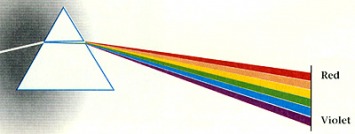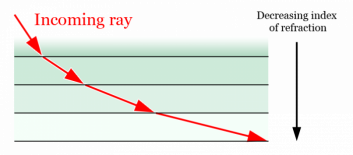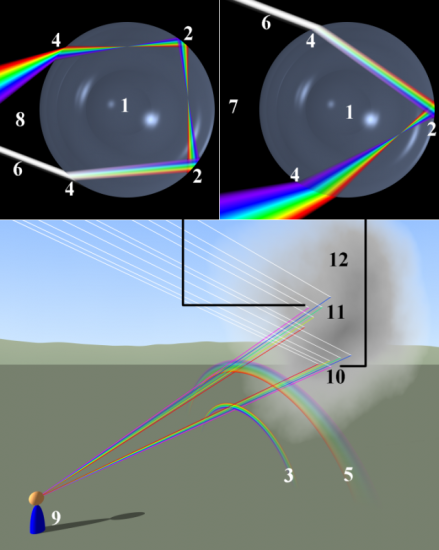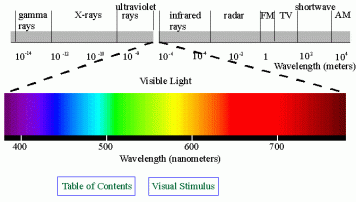Physics, Study of Matter and Matter's Physical Properties and Interactions

Physics of White Light Refraction, Color Separation, and Prisms
Physics is a science that deals with motion, mechanics, energy, electricity, light, radiation. Physics is a science that is closely associated with the purest of all sciences, mathematics.
People who like mathematics do well in physics and engineering sciences that rely much on math. However, even if someone does not like mathematics, the study of physics can be fun without math. One does not have to be Einstein to understand Einstein's theories, nor does a person have to be a mathematician to understand physics.
Astronomy is an interesting branch of physics that involves studies of the universe. Astronomers research the characteristics and properties of objects in space — the moon, sun, all of our planetary system, far-away stars and black holes, comets, meteors, meteorites. Some studies even relate to the beginning of the universe such as the big bang theory. Astronomers use telescopes to probe space and the universe.
People who like mathematics do well in physics and engineering sciences that rely much on math. However, even if someone does not like mathematics, the study of physics can be fun without math. One does not have to be Einstein to understand Einstein's theories, nor does a person have to be a mathematician to understand physics.
Astronomy is an interesting branch of physics that involves studies of the universe. Astronomers research the characteristics and properties of objects in space — the moon, sun, all of our planetary system, far-away stars and black holes, comets, meteors, meteorites. Some studies even relate to the beginning of the universe such as the big bang theory. Astronomers use telescopes to probe space and the universe.
Refraction of a Light Ray — Path Traced in Decreasing Refractive Index Glass, Water, Syrup, etc.

Light Ray Path in Decreasing Refractive Medium
A light ray gains speed as it moves through decreasing refractive index layers. If the refractive indices are reversed in the figure (reverse the arrow direction, and trace the light ray from the bottom right corner to the left corner of the figure), then the light loses speed and bends or curves more toward the vertical. Light bends whenever it moves from one refractive index type to another. Air has a refractive index of 1.0. Water and glass have higher refractive indices (sing. index) than air. An airborne light ray bends downward as soon as it enters water or glass, and its speed is slowed.
Here are 2 questions to answer. If the light ray is directly overhead, and perpendicular to the same medium it enters (not coming in at any angle to the refractive medium), what would a scientist expect to happen to the speed and direction of the light? Think carefully. Would the light ray bend right, or left, or not at all? Would the light ray speed up, or slow down as the refractive index decreases? Think like a scientist based on what is known about light ray behavior.
Here are 2 questions to answer. If the light ray is directly overhead, and perpendicular to the same medium it enters (not coming in at any angle to the refractive medium), what would a scientist expect to happen to the speed and direction of the light? Think carefully. Would the light ray bend right, or left, or not at all? Would the light ray speed up, or slow down as the refractive index decreases? Think like a scientist based on what is known about light ray behavior.
Rainbows Form by Sunlight Refraction in Water Vapor – Prism Effects

Primary, Secondary Rainbow Creation by Water Vapor Droplets (Credit, Pederson)
When sunlight passes through mist or water vapor, a rainbow can often been seen. The water droplets serve as lenses that refract the white light in the same manner as a glass prism does. The longest wavelengths (red) refract or bend the least, and the shortest wavelengths refract or bend the most as they exit a lens or prism.
Primary and Secondary Rainbows can be formed as sunlight passes into and through water droplets. The beautiful illustration by Søren Peo Pedersen shows 2 water droplets. Sunlight or white light enters (see number 6) each droplet in the upper figures. Light refracts (bends), and reflects (bounces off, like a mirror) inside the water droplets. Finally, as the light is 1. reflected and 2. refracted again at the ultimate and final refraction (see ray reflection at 2, followed by refraction and exit at 4), the full, visible light spectrum is revealed. The droplets each show the most bent violet rays, and the least bent red ray components. All the rays exit at the same time to reveal the final, full spectrum of colors.
The Total Visible Light Spectrum is displayed as red-orange-yellow-green-blue-indigo-violet light (ROYGBIV).
Each color is a proven part of white light. If a light prism were used to obtain this separation, then another prism could be used to recombine the prism-separated spectrum of light into white light — amazing, but true!
VISIT Our Science Super School Store
All the Written Material within Site is Copyrighted 2010 and Owned by Dr. Donald Reinhardt, and this original material is protected legally by this copyright notice and by the Digital Millennium Act. None of this original material may be copied or reproduced without the expressed written consent of the author.
The author is a Freelance Science writer, and is available for specific assignments for those who are interested – by contacting adminstrator@sciencesuperchool.com. Other questions related to this teaching site should be directed to teacher@sciencesuperschool.com.
Primary and Secondary Rainbows can be formed as sunlight passes into and through water droplets. The beautiful illustration by Søren Peo Pedersen shows 2 water droplets. Sunlight or white light enters (see number 6) each droplet in the upper figures. Light refracts (bends), and reflects (bounces off, like a mirror) inside the water droplets. Finally, as the light is 1. reflected and 2. refracted again at the ultimate and final refraction (see ray reflection at 2, followed by refraction and exit at 4), the full, visible light spectrum is revealed. The droplets each show the most bent violet rays, and the least bent red ray components. All the rays exit at the same time to reveal the final, full spectrum of colors.
The Total Visible Light Spectrum is displayed as red-orange-yellow-green-blue-indigo-violet light (ROYGBIV).
Each color is a proven part of white light. If a light prism were used to obtain this separation, then another prism could be used to recombine the prism-separated spectrum of light into white light — amazing, but true!
VISIT Our Science Super School Store
All the Written Material within Site is Copyrighted 2010 and Owned by Dr. Donald Reinhardt, and this original material is protected legally by this copyright notice and by the Digital Millennium Act. None of this original material may be copied or reproduced without the expressed written consent of the author.
The author is a Freelance Science writer, and is available for specific assignments for those who are interested – by contacting adminstrator@sciencesuperchool.com. Other questions related to this teaching site should be directed to teacher@sciencesuperschool.com.
